
|
SUMMARY:
Show, don’t tell. This classic writer’s maxim applies to your marketing as well. To spark your best-thinking around a key way to show your product or service’s value proposition, in this article we bring you 10 steps to improve your lead generation campaign using the value your company creates. |
Action Box: This MeclabsAI Workflow will build alongside you
Read the article below to get ideas. And then click here to try a MeclabsAI Workflow built to help you turn a client win into a lead gen campaign (from MeclabsAI, MarketingSherpa’s parent company).
“Marketers are too concerned with claims. The work of the marketer is more subtle. We should be more concerned with fostering conclusions than forcing claims,” said Flint McGlaughlin, Founder, MeclabsAI.
One way to help foster those conclusions is to let your company’s work ‘speak for itself.’ Well, that’s not an accurate analogy, now is it? If your work really did ‘speak for itself’ you wouldn’t need marketing. So in this article, we’ll show you how to get your work to speak for your company.
You might know me as a business reporter writing case studies for MarketingSherpa. But before this era in my career, I wrote promotional case studies for enterprise software companies (among other things).
In this article, I use that combined experience – plus a framework created by McGlaughlin using MeclabsAI as well as insights from marketers and entrepreneurs – to help you turn a client win into a lead gen campaign.
You’re essentially looking for the overlap between two key areas – the products and services your company wants to promote and what it is actually good at.
This may seem obvious, but often it’s not. Sometimes a company’s biggest wins come from the ‘old’ product or service while the company wants to move on to promote newer products or services that may be higher margin or just have better opportunities with a growing market. They’ll still book business for the old stuff, sure, but that’s not the focus of the company’s marketing budget.
Of course, when moving into a new area…well, your company may not be that good at first. It may be touch and go. Early customer experiences are pretty experimental. The services team hasn’t found their sea legs yet. The UI for the new product is confusing.
So prioritize. Get the big picture. Understand the overlap between the company’s goals and its achievements.
The first step was to make sure you see the big picture. Now let’s get small. Create an ideal customer profile for the prospect set(s) you are trying to attract to become a lead.
“Not every client success translates into an effective marketing asset. You need to filter for stories your future prospects will see themselves in,” advised Greg Carter, Senior Director of Demand Generation Marketing, Clutch.
We call this customer-first marketing at MarketingSherpa, but Carter used a different term – market relevance. Whatever you call it, your ultimate success does not come from focusing on your own goals, but by helping the kind of people you are trying to attract. “We align the firmographics of our outreach targets with the client success story. The closer it mirrors a prospect’s situation, the more likely it resonates,” he said.
Companies are value creation machines. Your job is to find that value. The bigger the company the harder it can be. And it’s not that easy in small companies either. Here are a few ideas for finding client wins you can use:
Another way to find the story is by celebrating your client’s wins with them. “We send a custom gift box with a useful, premium item, like a handcrafted cutting board and engraved knife featuring their name or company logo. Even if it’s chocolate, we source it from local artisans to ensure it’s exceptional,” said Jerina Vincent, Founder, JNJ Gifts and More.
For Vincent, it makes a lot of sense. This is the product she sells.
But I like the tactic because it takes us out of only focusing on our own self-interest – ‘got to get those leads and broadcast how our agency or technology did a great job’ – and shift the light where it belongs: on the customer.
No matter what your product or service did, your client played a key role in it (even if the only thing they did right was select your company, remember, they bet their business or job on that choice so kudos to them).
Plus, this approach in itself has value and can lead to good karma – which in the marketing world, we refer to as ‘word-of-mouth marketing.’
“This unexpected gesture creates an emotional connection and sparks word-of-mouth referrals. We always include a handwritten note encouraging the client to share their experience with others who might benefit from our services. Many post about it on social media or share it with colleagues, transforming a single win into a ripple of new opportunities,” Vincent said.
But you could also include a simple message in there about your customer champion program. Or ask if they would like to be spotlighted in your newsletter.
It is highly unlikely that you will be handed a story on a silver platter with a nice bow on it.
Get all the info you can dig up – meeting notes, a PowerPoint deck, metrics, transcript with an interview you did with an account exec – and then put together a rough outline of the story.
Think of it like you would a pitch to an editor at a newspaper. Why would the ideal customer care about this story? How would it help them? And how does it align with your company’s value proposition (even broken down to a specific product- or product-level value prop)?
Whatever you do, please, don’t just publicly share that story…yet. This is probably a good client for your company, and you do not want to alienate that relationship.
First, get an understanding of what this company has already agreed to with your company. If you have a services business, there is likely a contract. Is publicity addressed? If it’s a product, there may be a user agreement.
Then (just like you would with account-based marketing) understand the players on the other side. Who do you want to publicly quote about this story? And who has decision-making authority in the company? For example, if your person is a manager, it might be their director who needs to give the ok to make this public. Depending on the company, it may even be wise to involve the marketing or PR department (or agency).
Start with your company’s internal champion and write them an email using your marketing expertise. After all, this is internal marketing. Some elements you may want to include:
When I used to work in the enterprise software field, I would joke that case studies for some products are basically ‘software is magic.’ Everything was dire at Company A, then they bought our software, and now Company A is a land of unicorns and rainbows.
In fairness, there is some value in those kinds of stories. Just getting a major company in your industry to publicly state it used your product or service and got results could be what it takes to attract some people to be leads.
But in a higher-converting story, your product is just the best support actor. The real star is your client. Because the story doesn’t only show that they used the product or service, it shows how and why they did it.
So first, map out key points of friction or anxiety that are preventing your ideal customer from becoming a lead. What misconceptions do they have that are holding them back? Or even, what true conceptions do they have, but they just don’t know how to handle the situation?
Then you can see what elements are in each of your stories to highlight and show how this person and company (who is their peer) overcame these points of friction and anxiety to achieve victory. It’s a way to show (not tell) your ideal customer that they can do it as well and that the outcome is worth it.
Real stories are often messy and imperfect, which makes them more credible and relatable. “A high-converting story isn’t necessarily the most sensational – it’s the most believable. That simple shift helped us turn skeptics into buyers and one-time buyers into loyal fans,” said Patty Pavia, community education lead, biöm.
Once that story is published in some form, social media can be a great way to get the word out because the key people at the client can share the story from their own accounts giving great authenticity and credibility to your lead gen campaign. Then, your brand (and the people who work at your company) can boost those posts.
If key people at the client do not want to share it from their own social media accounts, at least see if you can share it and @ mention them.
For the right people, this can be part of the value of telling their story. They want their LinkedIn and other social media accounts shared with their peers.
You can includes links in the (paid and organic) social media posts to blog posts, gated studies, videos, PDFs, and other forms you have used to tell the client story.
Another benefit of social media can be the precise audience targeting it allows to reach out to people similar to the ‘heroes’ of your story. For that reason, it can make sense to tell several versions of the same story with different ‘heroes’ from the team. For example, Meclabs Institute (MarketingSherpa’s parent company) published both A Marketer’s Perspective on The Boston Globe’s Transformation and A Business Leader’s Perspective on The Boston Globe's Transformation from the same client win.
Not only can your client success story serve as lead generation, it can be key for lead nurturing as well. There are likely many people in your ideal customer set who have some sort of relationship with your company already – whether they are officially a ‘lead’ yet is determined by your company’s lead definition.
Reaching out with an email series covering different aspects of the client win might be enough to tip them from someone mildly interested in your company to officially become a qualified lead and ready to engage in the sales process.
Beyond publishing an article on your website, a client win can have so many uses in a presentation for webinars, conferences, and sales presentations.
You could also take the same story and deploy it in many formats. An interview of the client by one of your subject-matter experts, a presentation the client can deliver themselves, a sales presentation any of your reps can deliver on sales calls.
For the latter, it helps to build a library for your sales reps with many different stories addressing various industries, use cases, paint points, and anxieties potential customers have. Then the sales rep can use the most relevant client story for that particular prospect.
If you’ve executed along with us until now, many prospects have seen some element of the client win story at least once. And maybe they took a quick look, but darn, Slack is blowing up. Or Outlook just pulled them into a meeting. Their wife called because her SUV broke down. You get the idea.
Or maybe, they just weren’t in the right place in the customer journey to raise their hand yet. “After running dozens of case study campaigns, I realized we were missing out on prospects who showed initial interest but weren't ready to buy,” said Jasmine Charbonier, fractional growth and marketing strategy executive, Charbonier Consulting.
This again is where it can help to slice and dice up the story.
“Retargeting ads focus on different aspects – some highlight ROI, others showcase the implementation process, and some feature client quotes. We typically use a 90-day retargeting window and see about 15-20% of retargeted users converting into leads,” she said.
MeclabsAI Workflow: How to turn a client win into a lead gen campaign
Get Better Business Results With a Skillfully Applied Customer-first Marketing Strategy

The customer-first approach of MarketingSherpa’s agency services can help you build the most effective strategy to serve customers and improve results, and then implement it across every customer touchpoint.
Get More Info >MECLABS AI
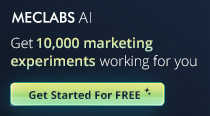
Get headlines, value prop, competitive analysis, and more.
Use the AI for FREE (for now) >Marketer Vs Machine
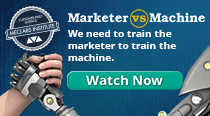
Marketer Vs Machine: We need to train the marketer to train the machine.
Watch Now >Live, Interactive Event

Join Flint McGlaughlin for Design Your Offer on May 22nd at 1 pm ET. You’ll learn proven strategies that drive real business results.
Get Your Scholarship >Free Marketing Course
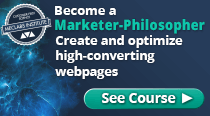
Become a Marketer-Philosopher: Create and optimize high-converting webpages (with this free online marketing course)
See Course >Project and Ideas Pitch Template
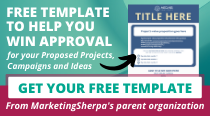
A free template to help you win approval for your proposed projects and campaigns
Get the Template >Six Quick CTA checklists

These CTA checklists are specifically designed for your team — something practical to hold up against your CTAs to help the time-pressed marketer quickly consider the customer psychology of your “asks” and how you can improve them.
Get the Checklists >Infographic: How to Create a Model of Your Customer’s Mind

You need a repeatable methodology focused on building your organization’s customer wisdom throughout your campaigns and websites. This infographic can get you started.
Get the Infographic >Infographic: 21 Psychological Elements that Power Effective Web Design
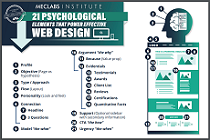
To build an effective page from scratch, you need to begin with the psychology of your customer. This infographic can get you started.
Get the Infographic >Receive the latest case studies and data on email, lead gen, and social media along with MarketingSherpa updates and promotions.